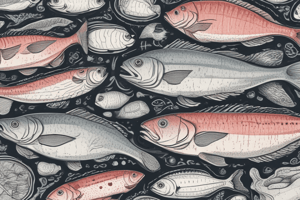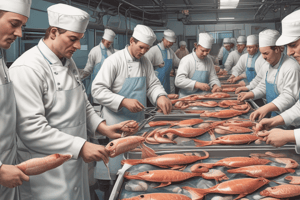Podcast
Questions and Answers
What role does seafood processing play in ensuring seafood is safe for consumption?
What role does seafood processing play in ensuring seafood is safe for consumption?
Seafood processing plays a crucial role by cleaning, filleting, and otherwise preparing seafood to make it safe and suitable for consumption.
Why are n-3 polyunsaturated fatty acids from fish considered beneficial?
Why are n-3 polyunsaturated fatty acids from fish considered beneficial?
N-3 polyunsaturated fatty acids are beneficial as they can reduce the risk of coronary heart disease, making fish a healthy alternative to red meat.
What is surimi and how is it produced?
What is surimi and how is it produced?
Surimi is minced fish meat that is produced by mechanically deboning fish, refining, washing, draining, and freezing it with cryoprotectants.
List some common methods involved in seafood processing.
List some common methods involved in seafood processing.
What are the characteristics of good quality surimi?
What are the characteristics of good quality surimi?
How significant is surimi in global fishery supply?
How significant is surimi in global fishery supply?
What steps are involved in the production of surimi?
What steps are involved in the production of surimi?
What is the primary purpose of deboning in surimi processing?
What is the primary purpose of deboning in surimi processing?
How do perforation diameters of 3-4mm affect the quality and yield of surimi?
How do perforation diameters of 3-4mm affect the quality and yield of surimi?
Why is washing minced meat a critical step in surimi processing?
Why is washing minced meat a critical step in surimi processing?
What characteristics do fish species used in the surimi industry generally share?
What characteristics do fish species used in the surimi industry generally share?
What temperature should the water be during the washing process and why?
What temperature should the water be during the washing process and why?
What are the consequences of under-washing surimi?
What are the consequences of under-washing surimi?
Name two fish species commonly used in surimi processing and their corresponding regions.
Name two fish species commonly used in surimi processing and their corresponding regions.
Explain how over-washing impacts the quality of washed meat.
Explain how over-washing impacts the quality of washed meat.
Describe the initial step in surimi processing and its importance.
Describe the initial step in surimi processing and its importance.
What is the purpose of washing the fish after de-heading and gutting?
What is the purpose of washing the fish after de-heading and gutting?
How does the number of washing cycles affect surimi quality?
How does the number of washing cycles affect surimi quality?
What role do sarcoplasmic proteins play in the functionality of surimi?
What role do sarcoplasmic proteins play in the functionality of surimi?
Explain the deboning process in surimi manufacturing.
Explain the deboning process in surimi manufacturing.
What is leached meat and how is it obtained in surimi processing?
What is leached meat and how is it obtained in surimi processing?
Why is it critical to completely remove the gut during the de-heading and gutting stage?
Why is it critical to completely remove the gut during the de-heading and gutting stage?
What steps follow the de-heading and gutting process in surimi production?
What steps follow the de-heading and gutting process in surimi production?
What is the ideal water-to-meat ratio for effective washing in surimi processing?
What is the ideal water-to-meat ratio for effective washing in surimi processing?
Why is increased washing in surimi processing considered undesirable?
Why is increased washing in surimi processing considered undesirable?
What method is used to remove water during the dewatering process in surimi production?
What method is used to remove water during the dewatering process in surimi production?
What role does salt play in the last dewatering step of surimi processing?
What role does salt play in the last dewatering step of surimi processing?
What is the final moisture level achieved through the screw press in surimi processing?
What is the final moisture level achieved through the screw press in surimi processing?
What primary cryoprotectants are mixed with dewatered minced fish meat, and in what percentage?
What primary cryoprotectants are mixed with dewatered minced fish meat, and in what percentage?
How does sodium tripolyphosphate and tetrasodium pyrophosphate function in surimi processing?
How does sodium tripolyphosphate and tetrasodium pyrophosphate function in surimi processing?
What is the ideal temperature maintenance during the mixing of cryoprotectants in surimi processing?
What is the ideal temperature maintenance during the mixing of cryoprotectants in surimi processing?
Flashcards
Seafood Processing
Seafood Processing
The process of preparing seafood for consumption, including cleaning, filleting, marinating, freezing, and more.
Surimi
Surimi
Stabilized fish myofibrillar protein, often called 'ground fish meat', used in various seafood products.
Seafood's Importance
Seafood's Importance
Seafood is a significant protein source for many cultures, often providing health benefits like increased intake of omega-3 fatty acids.
Surimi Production
Surimi Production
Signup and view all the flashcards
Surimi Properties
Surimi Properties
Signup and view all the flashcards
Fish as a Healthy Alternative
Fish as a Healthy Alternative
Signup and view all the flashcards
Cryoprotectants
Cryoprotectants
Signup and view all the flashcards
Fishery Supply
Fishery Supply
Signup and view all the flashcards
Surimi fish species
Surimi fish species
Signup and view all the flashcards
Alsaka pollock
Alsaka pollock
Signup and view all the flashcards
Surimi processing - De-heading & Gutting
Surimi processing - De-heading & Gutting
Signup and view all the flashcards
Surimi processing - Deboning
Surimi processing - Deboning
Signup and view all the flashcards
Fish gut removal importance
Fish gut removal importance
Signup and view all the flashcards
Surimi processing - Mincing
Surimi processing - Mincing
Signup and view all the flashcards
Surimi processing - Washing
Surimi processing - Washing
Signup and view all the flashcards
Surimi processing - Dewatering
Surimi processing - Dewatering
Signup and view all the flashcards
Deboning fish
Deboning fish
Signup and view all the flashcards
Optimal perforation size
Optimal perforation size
Signup and view all the flashcards
Surimi washing
Surimi washing
Signup and view all the flashcards
Sarcoplasmic proteins
Sarcoplasmic proteins
Signup and view all the flashcards
Washing cycles impact
Washing cycles impact
Signup and view all the flashcards
Water temperature (washing)
Water temperature (washing)
Signup and view all the flashcards
Deboned fillet quality
Deboned fillet quality
Signup and view all the flashcards
Surimi quality factors
Surimi quality factors
Signup and view all the flashcards
Washing Ratio
Washing Ratio
Signup and view all the flashcards
Washing Cycle
Washing Cycle
Signup and view all the flashcards
Dewatering
Dewatering
Signup and view all the flashcards
Refiner
Refiner
Signup and view all the flashcards
Salt Mixture
Salt Mixture
Signup and view all the flashcards
Synergistic Mixture
Synergistic Mixture
Signup and view all the flashcards
Silent Cutter
Silent Cutter
Signup and view all the flashcards
Study Notes
Seafood Processing
- Seafood is a popular protein source in many countries.
- Consumers are increasingly choosing fish as a healthier alternative to red meat.
- N-3 polyunsaturated fatty acids in fatty fish are associated with lower risk of coronary heart disease.
- Seafood processing is important for ensuring safety and quality.
Seafood Processing Steps
- Cleaning, filleting, mincing fish
- Marinating seafood
- Preparing sashimi
- Freezing fish and other seafood
- Opening oysters and shellfish
- Smoking salmon and other seafood
- Grading, shelling, and cooking prawns and other crustaceans
- Freezing seafood products (e.g., fish balls, imitation crab sticks, breaded fish fillets)
Surimi
- Surimi is minced fish meat; a popular Japanese product making up 2-3% of global fish supply.
- It's a stabilized fish myofibrillar protein, sometimes called "ground fish meat" or "concentrated fish protein."
- Made from fish that's mechanically deboned, refined, washed, blended with cryoprotectants, packed, and frozen.
- Widely used as an intermediate product in various seafood products/substitutes.
Surimi Processing:
- Raw Material: Receiving, sorting, cleaning, heading/gutting
- Deboning/Mincing: Separating meat from skin/bones using a deboning machine, followed by mincing meat
- Washing: Mixing minced meat with cold water(<5°C) to remove undesirable elements
- Refining/Dewatering: Improving surimi quality by removing water; further refining may involve a screw press
- Mixing: Mixing surimi with cryoprotectants and other ingredients; using silent cutter for efficient mixing
- Packing: Extruding into polyethylene bags (often colored), packing by weight (e.g., 10kg blocks)
- Freezing: Placing surimi in contact plate freezers until the core temperature reaches -25°C.
- Storage: Maintaining freezing temperature below -20°C to prevent protein denaturation; shelf life is approximately 2 years.
Factors Affecting Surimi Quality
- Biological factors (species, seasonality/sexual maturity, freshness)
- Harvesting & On-board handling (time/temperature from capture to processing)
- Processing (water quality e.g. temperature, hardness), Washing cycle, and wash water-to-meat ratio
Fish Balls
- Singapore imports surimi from multiple countries (Indonesia, India, Malaysia, Thailand, Vietnam).
- Roughly 50,000 tons of surimi (fish balls & fish cakes) are produced annually by manufacturers.
- Ingredients: minced fish (fresh or frozen surimi), water (40%), salt (3-5%), sugar (3%), mono-sodium glutamate (1%), and starches (3%).
- Salt aids in solubilizing myofibrillar proteins.
Fish Ball Processing Steps
- Comminution: Chopping/cutting and blending minced fish to make smooth textured paste.
- Forming: Creating the shape of fish balls.
- Setting (Gel setting): A transition from paste to gel, forming an irreversible gel state.
- Heating/Cooking: Increasing the internal temperature above 80°C to render food safe and induce gelatinization.
- Cooling/Freezing: Rapid cooling in freezers or blast chillers.
Improving Fish Ball Texture
- Starch: A common additive to create a chewy texture.
- Transglutaminase: A more expensive additive, aiding crosslinking reactions of myosin and creating a springier texture.
Studying That Suits You
Use AI to generate personalized quizzes and flashcards to suit your learning preferences.




